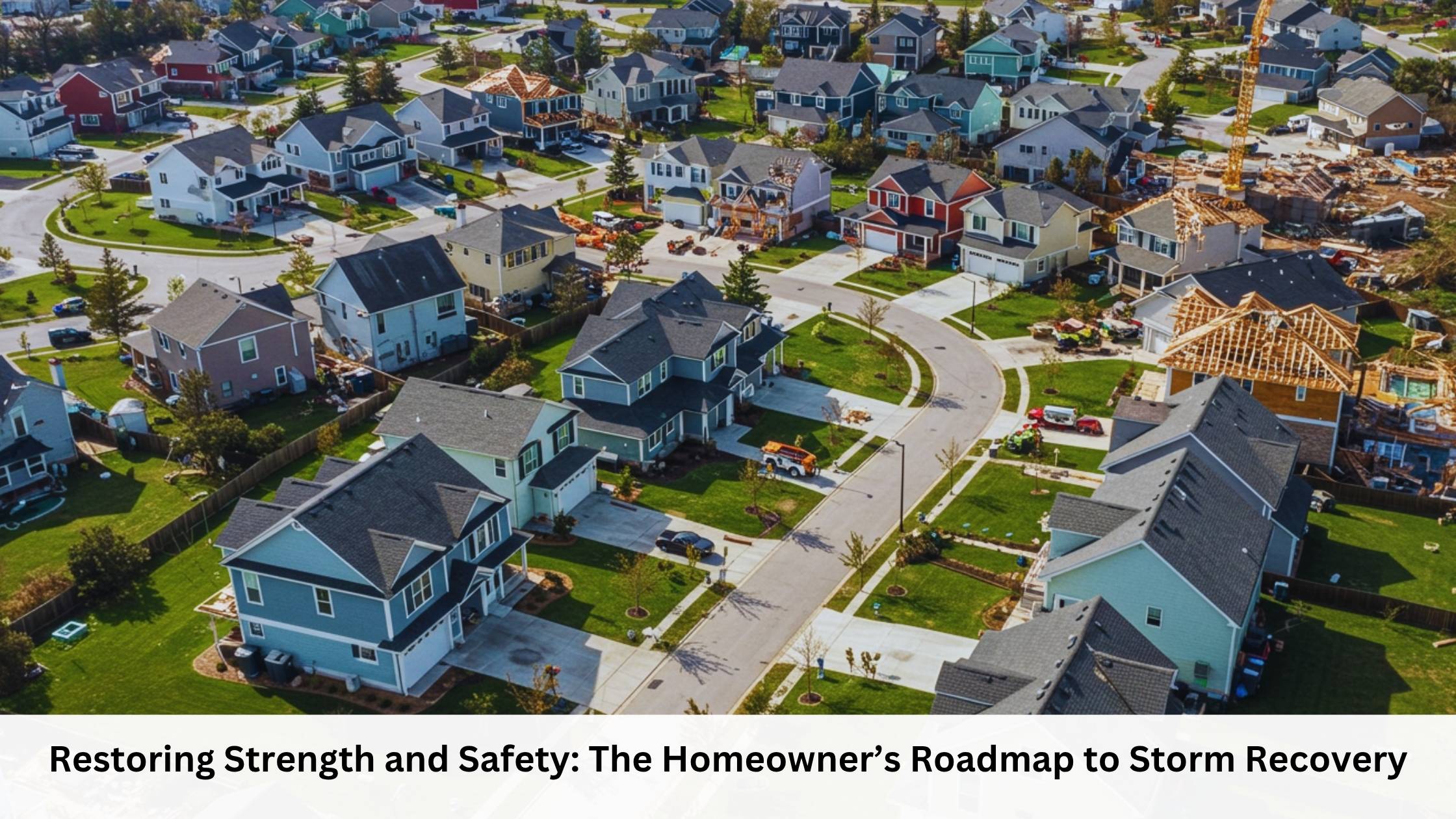Storms can strike without warning, and their aftermath often leaves homeowners facing extensive damage and difficult decisions. Whether it’s the result of heavy rain, high winds, hail, or lightning, the destruction a storm can cause to a home is overwhelming. Roofs may be torn apart, basements flooded, siding shredded, and personal belongings ruined. In times like these, storm restoration becomes not just a necessity but a lifeline to returning normalcy and security to your life.

This comprehensive article explores everything you need to know about storm restoration—from understanding the types of damage that can occur to navigating insurance, choosing the right contractors, and ensuring your home is better protected in the future. If you’re looking for reliable and professional storm restoration in Rockland understanding the complete process is essential to making informed decisions and ensuring the safety of your home and loved ones.
Understanding the Scope of Storm Damage
Storms can inflict damage in multiple ways, and sometimes the full extent of that damage isn’t immediately obvious. Depending on the severity and type of storm, homeowners may face a range of structural and environmental issues.
Types of Damage Commonly Seen After a Storm:
- Roof Damage: High winds can rip shingles off, hail can crack or puncture roofing materials, and falling branches can create holes or fractures.
- Water Damage: Heavy rain or flooding can lead to water intrusion through roofs, foundations, windows, and doors. Once inside, water can damage drywall, insulation, flooring, and electrical systems.
- Structural Damage: Strong storms can shift the frame of a house, crack foundations, or collapse walls. This type of damage is often the most costly and dangerous.
- Electrical and Utility Damage: Lightning strikes or falling trees can impact electrical lines, causing power outages and fire hazards.
- Window and Siding Damage: Hail and wind-driven debris often leave dents, cracks, or holes in siding and windows, compromising a home’s weather resistance.
Properly assessing and addressing all of these issues is a core part of effective storm restoration. Ignoring any of them can lead to long-term complications, such as mold growth, higher utility bills, or even structural failure.
The Immediate Steps After a Storm
Knowing what to do in the immediate aftermath of a storm can help you prevent further damage and start the recovery process as smoothly as possible.
Step 1: Ensure Safety
Before inspecting your home, make sure the storm has completely passed and it’s safe to go outside. Check for downed power lines, gas leaks, broken glass, and unstable structures. Avoid flooded areas and always prioritize safety over salvaging property.
Step 2: Document the Damage
Take detailed photos and videos of all visible damage. This will be invaluable for your insurance claim and will help restoration professionals assess the situation more accurately.
Step 3: Contact Your Insurance Company
Notify your insurer as soon as possible. Provide them with the documentation and be ready to answer questions. Some policies require claims to be filed within a specific timeframe, so don’t delay this step.
Step 4: Call a Restoration Professional
Attempting to repair serious damage on your own can be risky. Calling a company that specializes in storm restoration in Rockland County, NY ensures that professionals will handle the situation properly—from structural repairs to mold remediation.
Navigating the Insurance Process
The insurance claim process can be one of the most daunting aspects of storm recovery. Here’s what you need to know:
- File Promptly: The sooner you file a claim, the faster the process can begin.
- Understand Your Policy: Know what’s covered and what isn’t. Most standard homeowner’s insurance policies cover wind, hail, and lightning damage, but may not cover flood damage without a separate policy.
- Keep Receipts: If you make temporary repairs or spend money on accommodations while your home is uninhabitable, keep receipts for reimbursement.
- Get an Independent Inspection: In some cases, it can be helpful to have a third-party restoration expert provide a detailed report to support your claim.
Reputable companies offering storm restoration often work directly with insurance providers, easing the burden on homeowners and ensuring claims are handled fairly.
The Restoration Process: What to Expect
Once the damage has been assessed and your claim is underway, the full storm restoration process begins. This is typically broken down into several phases:
1. Emergency Repairs and Stabilization
To prevent further damage, professionals will:
- Tarp or board up holes in the roof or windows
- Pump out standing water
- Secure unstable structures
- Remove debris that poses immediate risks
2. Water Mitigation and Drying
Using industrial dehumidifiers and air movers, crews will dry out affected areas. Moisture mapping tools help identify hidden dampness in walls and floors to prevent mold.
3. Mold Prevention and Remediation
If water has been standing for more than 48 hours, mold may already be developing. Technicians will:
- Contain the area to prevent spores from spreading
- Remove contaminated materials
- Treat surfaces with antimicrobial solutions
4. Structural Repairs
The heart of the restoration process includes:
- Roof replacement or repairs
- Reframing damaged walls
- Replacing drywall and insulation
- Repairing or replacing flooring
- Electrical and plumbing fixes
5. Interior Restoration
This includes everything needed to return your home to its pre-storm condition:
- Painting and finishing
- Cabinetry and fixture installation
- Final cleaning and air quality checks
How to Choose the Right Restoration Company
Your home is likely your most valuable asset, and storm restoration is not something to leave to chance. Choosing the right contractor is key to a successful outcome.
What to Look for in a Storm Restoration Company:
- Licensed and Insured: This protects you from liability and ensures the work is done to code.
- Emergency Services: Fast response can prevent secondary damage.
- Experience and Expertise: Look for companies with specific experience in storm recovery, not just general construction.
- Insurance Coordination: A good company will help you navigate claims and provide documentation.
- Local Knowledge: Firms experienced in storm restoration will be familiar with local codes, common weather patterns, and permit requirements.
- Clear Communication: Transparent estimates, timelines, and progress updates are a must.
Preventing Future Storm Damage
While you can’t stop a storm from hitting, you can take steps to reduce the damage it causes in the future. After your home has been restored, consider making the following upgrades:
- Roof Reinforcements: Install hurricane clips and use wind-rated shingles.
- Impact-Resistant Windows: These help protect against flying debris and hail.
- Flood Barriers: If you live in a flood-prone area, install sump pumps and consider elevating your home.
- Back-Up Generators: Keep essential systems running during outages.
- Gutter and Drainage Improvements: Proper drainage systems help prevent water pooling around your foundation.
Routine inspections and maintenance can also go a long way toward minimizing storm damage.
Emotional and Financial Recovery
Storms don’t just damage structures—they disrupt lives. It’s important to acknowledge the emotional toll and seek support if needed. Rebuilding takes time, patience, and often a significant financial investment. But with the right help and approach, full recovery is absolutely possible.
- Stay Organized: Keep all restoration documents, receipts, and correspondence in one place.
- Create a Recovery Budget: Include insurance payouts, out-of-pocket expenses, and temporary housing costs.
- Lean on Community Resources: Local charities, churches, and disaster relief organizations can offer assistance.
Conclusion
Storm restoration is a complex, multi-phase process that requires professional expertise, strong planning, and emotional resilience. From the initial assessment and emergency repairs to long-term prevention, every step is crucial to ensuring that your home—and your peace of mind—are fully restored.
If you find yourself facing the aftermath of severe weather, don’t wait to take action. Contact a trusted provider specializing in storm restoration to begin the journey toward recovery. With the right support, your home can be rebuilt stronger, safer, and more resilient than ever before






